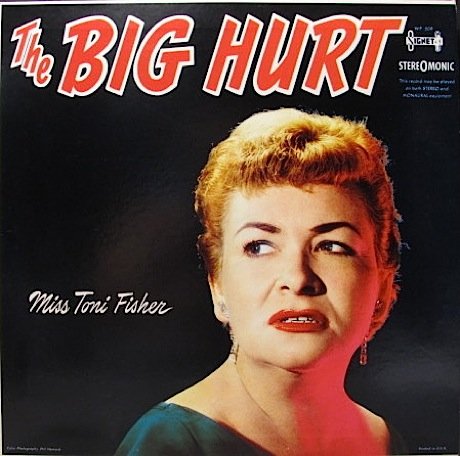Are effects special? I first encountered “The Big Hurt,” by Toni Fisher, referenced as the earliest use of the flange (phasing) effect – perhaps better known as ‘that sweeping noise,’ originally created by manipulating two simultaneous recordings of the same source. The term comes from ‘flange,’ the rim of the tape reel, which could be held down with a fingertip to create the effect – bringing to mind phalanges, the bones of the digits.
Skeletal technologies, doubled disassociations: it’s no surprise that “The Big Hurt” appeals to dark luminaries (namely Scott Walker and Nick Cave), while the image of Fisher on the cover of the eponymous 1960 LP rejects traditional pop-femininity in a portrait speaking to complex psychodrama. Curiously, the artist was specifically billed as ‘Miss Toni Fisher’ – like the song itself, the very fact that an appeal is made to the concrete known (i.e. gender) undermines the quality of definiteness which is intended, thus opening up a mirrormaze vista of sensibility.
“The Big Hurt,” lyrically, is a recognition of the onset of pain in a romantic loss (“Now it begins”), and its dragged-out eternality (“I wonder when/ Oh when will it end”). And this beginning is set to a discomforting and insistent beguine, over which emerges a labyrinth of shifting tones and key changes, reproducing the dislocated theme of the lyrics: a pre-postmodern house of leaves (the theme of alienated separation would also appear on Fisher’s tracks “West of the Wall,” about lovers separated by the Berlin Wall, and “The Red Sea of Mars”). The echoing sonics add to the sense of refraction, as do sighing strings which threaten to break into a stereotypical major-key pop chorus, yet slide away; and which give a chronologically impossible and eerie sense of pitch-shift as a purposeful strategy. The song both inhabits and refuses the listener’s ear, impossible to get a handle on, yet paradoxically memorable and addictive.
Despite these deflected discursions, the effect is achieved by a brutal brevity; there’s not a moment wasted in “The Big Hurt“‘s 130 seconds, and rather than a verse-chorus structure the tension builds to a single climax, a petite mort in jouissance mode, at the song’s end. To run with Lacan, there is a fundamental lack at its center, but one which is also, impossibly, a fullness of longing. We are somewhere between the glorious melodrama of the 50s, the death pop of the 60s, and the darkest aspect of psychedelia – that latter found in the surreal element of the flange. Del Shannon covered “The Big Hurt,” and like the electronic bleeps in his “Hats Off To Larry” – but in a less vengeful register – the unexpected technologesqueness gives the sense of a double mediation. It’s not that the tune arrives from outer space (as for The Ventures a few years later), but from the shadowy, phonographic past and the unimaginable future (now the present) simultaneously: from the childhood absence of the m/other, and from a posthuman state which is posthuman not from utopia, but from beyond the grave.
